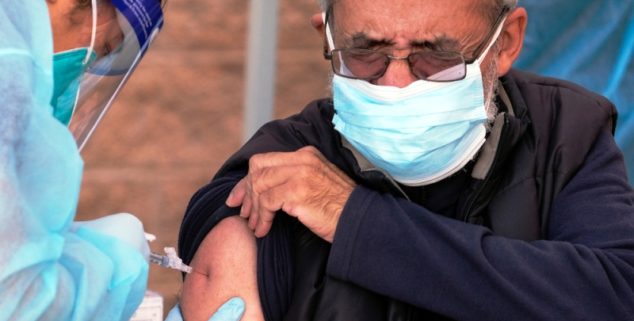Opinion
Community health centers offer true fairness in vaccinations
 A man receives a COVID-19 vaccination from a nurse at a clinic set up in the parking lot of the Los Angeles Mission. (Photo: Ringo Chiu, via Shutterstock)
A man receives a COVID-19 vaccination from a nurse at a clinic set up in the parking lot of the Los Angeles Mission. (Photo: Ringo Chiu, via Shutterstock)Many of the 55 elderly patients arrived for their second COVID-19 vaccines, leaning on their children’s arms or walkers. Most were Latinx or Black. All were age 75 or older, and they were eager to get vaccinated against the deadly virus.
None reported the trouble others have had booking their appointments because each was contacted by their health care provider, Venice Family Clinic. The Clinic is one of the state’s nonprofit community health centers that serve 7.4 million people of color and patients in low-income communities.
Many of our patients lack the computer savvy, home computers or broadband access needed to successfully book appointments at mega-sites.
Their immunizations illustrate how community health centers can easily reach the very populations the state is struggling to in its COVID-19 vaccination distribution effort. The clinics are active members of the vaccination network for all the state’s other vaccines. But community health centers have been all but left out of California’s COVID-19 vaccine distribution plans.
At Venice Family Clinic, for instance, we have only been able provide the required two doses to 55 of our 27,000 patients. We have been told we can count on about 200 doses each week, and we are using those for first doses. But 200 is a tenth of the Clinic’s weekly vaccination capacity of 2,000 doses.
These shortages apparently won’t change with Blue Shield taking over California’s vaccine distribution. It plans to double down on mega-sites and rely on an algorithm and incentives to seek equity in vaccine distribution.
There’s a more proven solution available in the community health centers. We serve one in five Californians, including the state’s essential workers and population groups that have suffered the most during the pandemic. More than half of our patients live at or below the federal poverty line of approximately $26,000 for a family of four. Nearly seven in 10 of our patients are people of color. About 370,000 of our patients are homeless.
The state’s vaccine statistics make clear the need to change course: Nearly a third of vaccines administered so far have gone to white residents.
Many of our patients lack the computer savvy, home computers or broadband access needed to successfully book appointments at mega-sites. Either they or, in the case of our oldest patients, their adult children who could help them, often work in jobs that don’t offer the time or opportunities to search for appointments.
If they get an appointment, most don’t have a car to get to a mega-site, such as California State University, Los Angeles. They would have to take two or three different buses and as much as two hours to get there. If they’re working, they would have to take the day off and, for most of them, that means no income that day.
As a result, they’re calling us, and we cannot provide the care they need – even as they continue to work where they are exposed to the virus and face the potential of bringing it home to other family members.
The state’s vaccine statistics make clear the need to change course: Nearly a third of vaccines administered so far have gone to white residents. The Latinx population in California has received just 16% of the vaccines and Black residents have received 2.9%.
President Joseph Biden recognized the power of community health centers to close these gaps in health disparities, when he announced his plan for a nationwide vaccination partnership with them. But his plan falls short as well: He’s proposed 1 million doses for 250 of the nation’s 1,370 community health centers, which serve 30 million people.
No algorithm or incentives can replace the trust community health centers have developed in the very communities the state and Blue Shield wish to reach. For more than 50 years, Venice Family Clinic has been taking care of generations of families. Other community clinics have long histories of serving patients in low-income communities and people of color.
While distrust of government is among the reasons cited for vaccine hesitancy in communities of color, our patients know us and trust us. We simply ask the state and Blue Shield to give us adequate vaccine supplies so we can protect our patients and help meet our goal of equity in vaccine distributions.
—
Editor’s Note: Anita Zamora is a registered nurse and the Chief Operating Officer of Venice Family Clinic, a nonprofit community health center that serves people in need, regardless of their ability to pay or their immigration status.
Want to see more stories like this? Sign up for The Roundup, the free daily newsletter about California politics from the editors of Capitol Weekly. Stay up to date on the news you need to know.
Sign up below, then look for a confirmation email in your inbox.

Leave a Reply